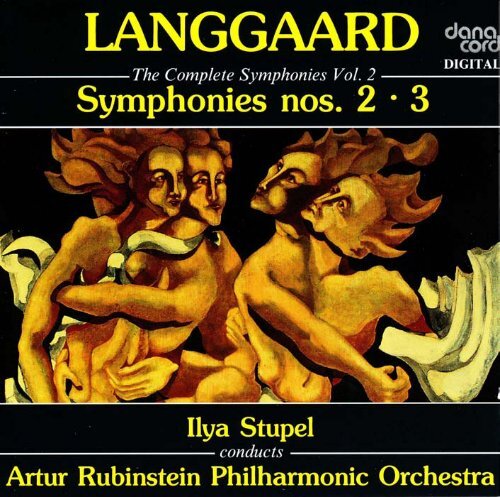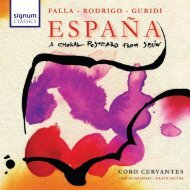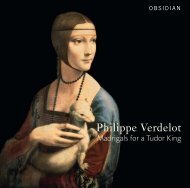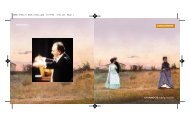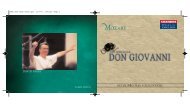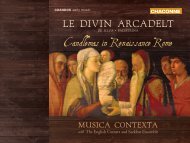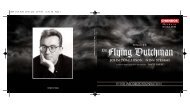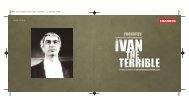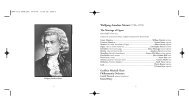You also want an ePaper? Increase the reach of your titles
YUMPU automatically turns print PDFs into web optimized ePapers that Google loves.
Rued Langgaard<br />
(1893<br />
- 1952)<br />
Symphony no.2 (1912-1411926-33) BVN 53. (Manuscript)<br />
'Vaarbrud" ("Vaarsange") Break of Spring (Spring Songs) .?B.24<br />
EAllegro 18.4J<br />
p Moderato con poco moto9.42<br />
pSymphony no. 3 (1915-16/1929-33) BVN 96. (Manuscript)<br />
"Ungdomsbrus" ("La melodia") Rustle of Youth 28.0J<br />
@Drapa (1907/09) BVN 20 (Manuscript) 6.24<br />
(Ved Edvard Griegs Dod) (Upon the Death of Edvard Grieg)<br />
Roma Owsinska, Soprano [2]<br />
Tadeusz Chmielewski, Piano [3]<br />
Ilya Stupel<br />
Artur Rubinstein Philharmonic Orchestra<br />
BVN refers to: Bendt Viinholdt Nielsen: Rued Langgaard's Compositions<br />
An Annotated Catalogue of Works. Odense Universitetsforlag 1991.
Rued (Rud) lmmanucl Langgaard was<br />
born in Copenhagen on 28th July l{t93,<br />
the only child of the composer and pianist<br />
Sieglried Langgaard (llJ52 - 1914)<br />
and his wif'e, the pianist Emma Langgrard.<br />
nce Fo's. Hc uf rcsfccting<br />
-ufcw<br />
the classical-romantic tradition in Danish<br />
music, which spanned tiom Nicls W.<br />
Gade to Horneman, and adnriring foreign<br />
composers such as W:Lgncr and<br />
Liszt. Sieglried Langgaard had studied<br />
with Liszt for two periods during 1878 -<br />
79, and the piano concerto he composcd<br />
was the llrst insttrnce of the great lateromantic<br />
concerto in Denmark.<br />
Ruetl was giren his lirst pilno tuition<br />
by his nrother aged only five, ancl within<br />
two years he had mastered Chopin's mazurkas<br />
and Schumann's Daviclsbiindler-<br />
Tdnze. His lather then took over the<br />
trair.ring of thc your.rg boy. who at aboul<br />
this time produced his t'irst compositions.<br />
His Iurther theoretical studies took place<br />
at thc Horncman Conscrvatoire of Music.<br />
and he studied the violin and organ<br />
with Messrs. C. PeLersen and G. Helsted<br />
respectrvely.<br />
Langgaard's lirst public appearance<br />
was at a recital in Copenhagcn's Marmorkirken<br />
in 1905, at which he in,provised<br />
at the organ. Gricg was present and<br />
expressed his ardmiration for the prodigy.<br />
His c16br:t as a composer came in 1908<br />
with the choral work Mu.sac trium-<br />
phuttcs. which he had completed two<br />
ycars carlicr. but it w:rs not well received.<br />
Durir,g the same year hc commcnccd<br />
work on his first symphony which was<br />
given its first pcrformance in 1913 by the<br />
Berlin Philharn.ronic Orchestra under no<br />
less a figurc than Max Fiedler. Thc symphonic<br />
poem Sfn-r.- was premiered at the<br />
same oonccrt. which thus established<br />
Langgaard as a highly-gified and extremely<br />
promising yor:r'rg composer.<br />
Alier the death of Langgaard pdre in<br />
1914. the young man's mother became<br />
the focal point of his life, watching and<br />
(over-)protecLing her remole and rntroverted<br />
son's artistic dcvclopmcnt. ln a<br />
lctter to a lirniily friend the lady quoted<br />
her son as follows: "l (Rucd Langgaard)<br />
want Lo wander orr sacred paths, paths<br />
open not unto mankind but unto the<br />
spirit alone. Earthly spheres are too low<br />
fbr me; humarn emotion, in so lar as it adhercs<br />
to thc body, too imperf'ecL". Evidence<br />
indeed of a sensitive and original<br />
young person!<br />
Three months aftcr thc death of his f a-<br />
Lher Langgaard made his conducting d6but<br />
at thc Copenhagen Music Society.<br />
During this period he was also assistant<br />
organist at thc Marmorkirken and Garnisonskirken<br />
churches while, as a composcr,<br />
thc years liom 1910 to the early<br />
1920's were his rnost productivc and artistically<br />
successful. He was awarded a
number of grants as well as a lif-e-long annual<br />
bursary from thc Danish goverument.<br />
Bctween 1920 and 1923 he Lravelled<br />
to Germany, Austria, Switzerl:Lrrd<br />
and ltaly. conducting his own works (the<br />
4th symphony in Heidelberg and Darmstadt)<br />
and hearing thc interpretations of<br />
others (thc 2nd symphony ir.r Vienna, in<br />
1922).It was also at this time that hc began<br />
to withdraw from thc established<br />
Danish, or rather Copenhagen, musical<br />
life. A series of vehemcnt alLacks by his<br />
mother on the new musical icleals of the<br />
age dragged Langgaard and his lateromantic<br />
idiom into thc struggle between<br />
what was secn Lo be performablc and<br />
what was lto longer considered tomme il<br />
faut. The new purist attitude to church<br />
rr.rusic similarly left Langgaard's sublective<br />
and evoc:rtive artistry out in the cold.<br />
While his artistic ability was ol course all<br />
his own. thcrc can be little doubt that his<br />
domineering parcnts. with their roots in<br />
the earlicr generation's esthetic ideals,<br />
and in particul:Lr his firLher's theosophical<br />
beliefs. lcti the young Langgatrrd in a situation<br />
that was to the benefit of ncithcr<br />
himself nor Danish music in general. He<br />
had - like the hero of an inverse Hans<br />
Christian Andersen lairy-talc - turned<br />
frorn a white duckling into an ugly swzLn.<br />
His nrother died in 1926 and, one year<br />
later, Langgaard married Valborg Constancc<br />
Tetens, who wits two years his sen-<br />
ior and who had been living with the f amily<br />
fbr fbur years. Ap:rrt ll-onr a brief tcnurc<br />
as organist at thc church of Christiansborg<br />
Castle in (iopenh:rgcn fronr<br />
1926 lo 1929 his applications for a pennanent<br />
position as an organist were ln valn.<br />
During the 1930's Langgaard's output,<br />
which by then totallcd more than 200<br />
works, bcgan to fall dramatically. Apart<br />
from the revision of the 5th symphony<br />
only onc major work - Messi..t. a drama<br />
fbr orgar, in thrce "evenings" - appeared<br />
cluring this period. In 1927 he lourrded<br />
his own Classical music Society, in order<br />
to 'counterbalance Lhe horrors of modern<br />
music'. but it came apart al1er only thrcc<br />
concerts.<br />
ln 19210, at the age of zl7, he was madc<br />
organist at thc cathedral of the small<br />
Wc:t Jutland tou n of Ribe. an irpporntnrent<br />
he himsclf considered his final banishmcnL<br />
lrom Copenhagen musical lif'c.<br />
A largc number of his liturgical organ<br />
works were composed in Ribe, as were<br />
the last scven synrphonics. Much of his<br />
production from this latter period were<br />
to remain unperformed. among them the<br />
16th and last symphony, composed the<br />
year beforc his death on lOth.luly 1952.<br />
Atler her husband's death Constance<br />
I anggarrrd madc a greut eflort Lo brilrg<br />
order and system to the wealth of music<br />
he had lcft, and her list was the only catalogue<br />
in existencc until Bendt Viinholt
Nielsen in 1991 publishcd his completc.<br />
annotated catalogue on Odense University<br />
Press. Upon Constance L:rnggaard's<br />
death in 1969 thc composer's works were<br />
entrusted to a foundation.<br />
Langgaard's output was prodigious.<br />
The total of more than 400 works, including<br />
adaptions, arrangemcnts and numcrous<br />
revisions and reworkings are difficult<br />
to survey. The symphonics wcre performed<br />
but a few times: many received<br />
their flrst perlbrmances only scvcral ycars<br />
aftcr Langgaard's death, partly because<br />
only a few of them were evel printed. Thc<br />
music is powcrful and direct. but the<br />
many revisions of the large-scale works in<br />
particular failed to tighten up their form,<br />
or limit the sudden and abrupt outbursts.<br />
It is at onoe full of contrasts and primitivist,<br />
if also invariably genuinely human in<br />
its constant swings in mood- As a lateromantic<br />
Langgaard was not alier thc<br />
merely ostentatious ancl calculated<br />
breadth o1'a Tchaikovsky or a Rachmaninov,<br />
but rnore the immcdiatc and pure<br />
sentiment such as chaotically siezed hirn<br />
as he composed.<br />
His skill in orchestration was no less<br />
than masterly and. without rcgard to any<br />
orchestral difficulties. he created quite<br />
unerpected sonorities and harmonic cff'ecLs<br />
based on thc classical ideal he never<br />
betrayed. This goes not just for the 16<br />
symphonies: the piano and organ works<br />
too take the maximum advantage of thc<br />
possibilities of' their instruments. The<br />
chambcr music and the more than 150<br />
sonp\ sho$ greal melodic inrentircnes:<br />
paired with a keen poetic scnsibility.<br />
The works from between l9l0 and 20<br />
are tbr Lhe most part influcnccd by the<br />
great late-romantic manifestations of the<br />
time. and both Richard Strzruss. WiLgner<br />
rnd others are hinted at. Towards the<br />
1930's there is a shili towards a more<br />
subciued. refined- expressiveness with a<br />
clear. transparent structure. The great or'ohcstral<br />
piccc Sfnrernes Mu,vk (The Music<br />
of the Spheres) would be an examplc.<br />
Starting with the third symphony the<br />
symphonies tend to be of one movcmcnt,<br />
varying ir.r length from half an hour to<br />
just six mirrutes. During the early pcriod<br />
nature was a great inspiration to Langgaard<br />
- his famrly's summer holidays in<br />
Swcdcn in particular were to leave their<br />
mark on his music - but belbre long this<br />
lyricism was to fuse with an almost overpowering<br />
sense of religion. where his contestation<br />
of (and fascination with) the triumph<br />
of evil over good, the sLruggle<br />
between light and dark. God anci Satan.<br />
and fear of the inferno and perdition<br />
were to lind powertiLl exprcssion in his<br />
music. In no piece does he den'lonstrate<br />
his humane concern and basic philosophy<br />
more Ibrcefully than in the biblical<br />
opera Antikri.sl (Antichrist). recognized
as being one of his masterworks.<br />
Thanks to his absolute m:rstcry of the<br />
orchestra, enabling him to compose complicated<br />
r/ilrsi for thc strirrgs, prescribe<br />
doublings in the wind section (whcre frequently<br />
the piccolo and E llart clarinet are<br />
to sound together, fbr instance) and the<br />
eclectic selection of percussion instruments<br />
of which he avails himsclf, Langgaard<br />
was easily carried away by his emotions<br />
and in many of his rnajor works he<br />
anticipates composers such as lves.<br />
Hindemith and Messi:rcn. But wherever<br />
Langgaard fbund his inspiration, his nrusiu<br />
was rrerer lcss than religiou.: it was<br />
through his compositions that hc fought<br />
hi. religiorr. strugglc. At thc \ame tirne.<br />
dcspite the bizarre titles :rnd programme<br />
notes some of Lhe works bore - strange<br />
word combirtations of hi. outt ittretttiott,<br />
and onomatopoeic words as headings for<br />
Lhe works - his music is also absolutely<br />
"pure" music. An example of his choice<br />
of words would be the direction to play<br />
sonlething "white-l.rot"; alr'rong his tenrpo<br />
indicatiorrs are to be found "furioso mortrf'ero",<br />
"schnervolc" (mockingly) and<br />
"pesantc colerico". Other rcplacements<br />
Ibr the more common character indications<br />
included those inspirecl by naLure,<br />
such as "Forcst Roar". "Brightening<br />
Weathcr" arrd "Thunderclor-rds". Such<br />
ambiguos titlcs n-right create the imprcssion<br />
that Langgaarcl's music is little more<br />
than Lhe undisciplined music of' ecstasy.<br />
but in fact hc is always in control of the<br />
physrcal framework of his seLtings, and<br />
as a symphonic poet he is a grcat storyteller.<br />
But in thc symphonies - which<br />
would be more properly classed as symphonic<br />
poems. :rs thcy are not in a classical<br />
sense symphonic ol form - his choice<br />
of title and descriptions frequently<br />
crcatcs more confusion than cl:rrification.<br />
Langgaard has bcen criticized for recycling<br />
ofien lairly large chunks of earlier<br />
pieces in ncw works, but he could see<br />
nothinB urung in relurnirrg to emotions<br />
and moods that held him on earlicr occasjons<br />
and quoting them in new works<br />
uhcrc lhc nrcssJge he wus trling to get<br />
Jcr!)ss wi.is I hc :antc. Thesc emolions a rc<br />
easily recognized given Langgaard's clever<br />
utilization of all the orchestra's possibilities:<br />
lrom the ironic and sarcastic to<br />
thc transfigured, appealing ancl profor-rndly<br />
fcrvent. Langgaard mastered the<br />
harmonic tonal idiom to perfection, and<br />
saw in it the enduring capacity of music<br />
to af-fect the hurnan spirit.<br />
His missron went through music and<br />
when he sat composing, frequently vcry<br />
carly in the moming, thc music would<br />
seize him so that the end result - howcver<br />
pastiche-like and rhapsodic it might at<br />
times seem - always bore witness to an<br />
honest and genuinc human struggle, onc<br />
that lcaves no-one untouched.
Symphony no. 2 "Break of Spring"<br />
Langgaard produced the first sketches<br />
fbr his second symphony during March<br />
1912, but it was not until the summer holiday<br />
that he spent with his parents in Kyrkhult<br />
in Blekinge, Sweden, betwccn June<br />
and August of that year that the final draft<br />
was completed. The following ycar, after<br />
the succesful perfbrmance in Berlin in April<br />
1913 of his lirst symphony, the fan.rily was<br />
back in Blekingc fbr its summer holidays,<br />
and work on the second symphony oontrnucd.<br />
Thc young Langgaard was at the tin.rc<br />
much taken by thc work of the German<br />
poet Emil Rittershaus, who was reprcscnted<br />
with several volumes in his parents' library,<br />
and Langgaard composed a number<br />
ofsongs to texts by Rittershaus in the years<br />
to 1916. By March l9lzl Langgaard had<br />
completed the orchcstration of the symphony<br />
and incorporated in the last movement a<br />
soprano solo to words by Rittershaus. The<br />
text derives in fact from two poems:<br />
"Lcnzkldnge" ("Sounds of Spring") and<br />
"Im Lenze" ("ln Spring"), ll"onr the anthology<br />
"Natur". Eight months later, in<br />
November lql4. thc slmphony was given<br />
its first performance at the Danish Concert<br />
Society in Copcnhagen by the composer<br />
Louis Glass who, incidentally. had also incorporated<br />
a vocal part in his own second<br />
symphony. The Langgaard work was given<br />
again in 1917, this trme with Langgaard<br />
himself conducting, and in the Ibllowing<br />
years it was played in Germany, in Essen<br />
and Berlin, and broadcast in South Germany.<br />
ln 1922 Langgaard heard a perfbrmance<br />
of it in Vienna.<br />
In its original version the symphony was<br />
in three movements and playcd lbr 40 minutes,<br />
but in June 1926 Langgaard commenced<br />
a revision. and only in 1933 did it<br />
find its tlnal tbrni. The symphony as we<br />
hear it today differs from the origir.ral vcrsion<br />
primarill in thrt the first two movements<br />
have become one, and that approximatly<br />
half of the material of the first<br />
movement has been excised. For the first<br />
perlbrmance of the newversion in 1948 - under<br />
the dircction ofLauny Grondahl - the title<br />
had also been changed, from<br />
"Vaarbrud" lo "Valrsrrtge".<br />
More than anything elsc it was nature that<br />
ir.rspirecl the early works. From the songs<br />
with their celebration of spring to the summery<br />
nature of the piano works with titles<br />
such as "Summer Day", "Morning at the<br />
Beach" and "Night-timc on the Sound"; to<br />
the trio entitled "Mountain Blossom" and<br />
finally to the desoriptions of nature in the<br />
first symphony there is the same, wonderfully<br />
sensitive blend of nature symbolism and<br />
pict1. Progranrme musie in the strict scnsc it<br />
is not; nor is it thc outer, more or less random<br />
f'ace of nature Langgaard is attempting<br />
to record, but the stirrings of the human<br />
soul that are awakened through coexistence<br />
with nature.
Hor'ich rings die Lerchcn singen<br />
Wenn:o mild die Sonne scheint,<br />
Ist es mir, als Hritt' ich nimmer<br />
Trdnen auf der Welt gcwcint<br />
Und ich glaub' das alte Mrirchen<br />
Dass die Lerchen hoch im Blau'n<br />
Unserm Herrgott in den Himmel<br />
und die schonen Engel schaun!<br />
Schau die Birken und die Buchen<br />
Tragen schon ihr Sonntagskleid.<br />
Denn der Sonntag fiir die Erde<br />
Ist die Liebe Friihlingszeit.<br />
Hundertstimmig singt und klingt es A hundred voices sing the mcssage<br />
Durch die Felder, durch dcn Hag:<br />
"Sei gegriisst nach kalten Tagen<br />
Sei gegriisst, du Sonnentag!"<br />
Weisse Glocklcin auf der Wiese<br />
Lauteten den Sonntag an;<br />
Duft'ge Blumcn haben ihre<br />
Schonen Augen aufgethan<br />
In des Windes leisem Rauschen<br />
Tont's wie ferner Orgelschall,<br />
Und die allerschonstc Predigt<br />
Hrilt im Wald die Nachtigali<br />
Freu'dich, Herz, im Sonnenglanz<br />
O, lass die volle Lenzespr:rcht<br />
Durch deiner Seele schweben.<br />
Emil Ritter"ghttus<br />
When I hear thc lark sing,<br />
When the sun shines bright,<br />
It sccms to me that I have never<br />
Shed tears upon this earth.<br />
Then I believe the old tale<br />
That the larks on high<br />
Our lord God in Heaven<br />
And his wondrous angels can see!<br />
Scc, the birch and the beech<br />
Are already in their Sunday best<br />
For, for the earth, Sunday<br />
ls the precious springtime.<br />
Across the ficlds and meadows:<br />
GreeLings, after all the cold days,<br />
Greetings, dc:rr Sunday.<br />
White snowdrops on the meadow<br />
Ring in the day,<br />
Sweet-scented Ilowers<br />
Lift their eycs in greeLing.<br />
Through the gentle rustling of the breeze<br />
It sounds like a distant organ.<br />
And in thc wood the nightingale<br />
Holds the most beautiful sermon of all.<br />
Rejoice. heart, in the brilliance of the sun.<br />
Let the full glory of the spring<br />
Flow through your soul.
Symphony no. 3 "Rustlc of Youtli"<br />
("La melodia")<br />
Lzrnggaard's tirst attenrpt at a real concerto<br />
for piano and orchcstra was made in<br />
1915, with Koncert Allegro alla Fantasia<br />
for piano solo which was transformed into<br />
a Koncert alla Fantasia tbr piano :rnd orchcstra.<br />
By March 1916 this Koncert alla<br />
Fantasia had found its final fonn as a symphony<br />
(no. 3) for piano and orchestra (and<br />
mixed chorus ad lib-) Already with his sccond<br />
symphony Langgaard had relaxed the<br />
classical form. and thc rigid conccrto lbrm<br />
would presumably have held no interest for<br />
him (he never did complctc a classical solo<br />
concerto and left only a very short movement<br />
1'or a violin conccrto). although he<br />
did, in 1935, revise and arrange some Llnpublished<br />
works in this form by his father,<br />
Siegliied Langgaard.<br />
The symphony was givcn its lirst perfbrmance<br />
in Coperrhagen in 1918" with Victor<br />
Schiolcr at the keyboirrd and the composer<br />
conducting. As a motto for thc symphony<br />
Langgaard had noted the fbllowing lines, a<br />
poem attributed to Axel Lunclcgaarcl: Eternal<br />
light, holy f1ame, alwzrys changing. forever<br />
the same. Always dying, forcvcr running.<br />
:rlways seeking, never finding.<br />
Greetings, sacred force, thc light of truth<br />
gave us lile.<br />
After the conccrt Severin Christensen<br />
of the journal "Musik" notcd thc following<br />
rcflccLions on the third symphony:<br />
There were plcasrng dctails in La Melodia.<br />
The deploymerrt of the'piano as an ordin:rry<br />
orehcstrrtl irrstrurnent uc5 intere\lirlq<br />
and produced an cxceptionally bcautilul<br />
sound. The symphony's motto clearly establishes<br />
thc spirit and decides the lbrm.<br />
Alier the introduction with a first-rate. energetic<br />
and niccly-turned m:rin theme, the<br />
organic unity is broken in two by a quite<br />
wonderftrl. funcral march-llke grote maeslo.ro;<br />
that it is repeated, unchanged, ir<br />
couple of timcs contradicts Lhe motto. The<br />
last section struck me as being thc most importa<br />
nt one: there is here a mystical.<br />
"double" mood about the motifs, ancl at<br />
thc cnd there appears a version of La Melodia<br />
as wonderl'ully sublime and bcautiful<br />
as anything in Danish music. A strangely<br />
conrposite thiurosturo lies across this closing<br />
scction - ir piece ol'music such as this<br />
should suffice to establish this composcr's<br />
rcputation as an outstanding symphonist.<br />
As with thc second symphony Langga:rrd<br />
reverted to the work at the end ofthe<br />
I 920's and madc scveral revisions and cuts,<br />
Ieaving the 30-odd minutes of the prcscnt<br />
version. ln 193.1 Lhe symphony was performed<br />
by the state broadcasting systcm,<br />
albcit without chorus, with Emil Reesen<br />
conducting. This Langgaarcl's firsL onemovement<br />
symphony was given titles such<br />
as "Sounds of Miclsummer" and "Melodies<br />
of Youth" besides La Mclodia before<br />
Langgaard seLLled for "Rustle of Youth".
Drapa<br />
(Upon the Death of Edvard Grieg)<br />
Two nronths aftcr thc con'rpletion of<br />
the grcat wotk Musue lriumplktntes. Ihc<br />
young Langgaard composed Drapa betwccn<br />
the months of April anci July of<br />
1907. The subtitlc "Upon the Death of<br />
Edvard Grieg" was in tact adcicd only af:<br />
ter the work hacl been completed. in that<br />
Gricg died on z[ September 1907. Gricg<br />
had contact to thc Langgaards on a numbcr<br />
of occasions; he had bccn prcsent at<br />
the young Rued's organ concert at Copenhagen's<br />
"Marble Church" on 7 April<br />
1905 and had sent the boy's rnothcr :t<br />
note marking his respect.<br />
Drapa is the Old Norse word lbr thc<br />
Icelandic hcro legends and religious<br />
poems. They are rooted in ninth century<br />
Norway and deal with the feats of princes<br />
and kings.<br />
In 1909 - probably during a summcr<br />
holiday in Tulscbocla Brunn, Sweden -<br />
the work was reorchestratcd and on 6 December<br />
1909 tlie first perfbrmance was<br />
given at the Danish Conoert SocieLy under<br />
the dircction of the composer Victor<br />
Bendir.<br />
Thc producer would like to thank thc fbllowing<br />
individuals and foundations:<br />
Messrs. Sten Uldal and Bcndt Viinholt<br />
Niclscn.<br />
I-anggaard Fondcn<br />
Hotelejer Andreas H:Lrboes Fond<br />
Augustinus Fonden<br />
Konsul Gcorgc Jorck og hustru Emma<br />
Jorck's Fond<br />
Johannc og Ejnar- Flach-Bundegaards<br />
Fond.<br />
,lJesper Buhl<br />
English translation: Pcr Sommerschield.<br />
llya Stupel - a rising star in thc musical<br />
firmament who has been described as one<br />
of the greatest conducting talcnts in the<br />
world - w:rs born on 13th Decembcr 1949<br />
irr Vilnius. Lithrr;rnia. He grew up irr a<br />
family whose rich musical traditions went<br />
back for scvcral generatjons. He first<br />
started playjng the piano aged only three,<br />
and was rcfcrred to as a child prodigy after<br />
he had joined the Conscrvalory tn Vilnius.<br />
h.r 1957 Ilya Stupel moved to Poland<br />
where he continued his musical<br />
training; at the san'le time he was cngaged<br />
as assistant to Lhe famous conductor and<br />
teacher Bohdan Wodiczko of the Katowice<br />
Radio Symphony Orchestra<br />
(WOSPR). Stupel's Jcwish descent has<br />
had a strong bearing on his fortunes, ancl<br />
every time his carecr has seemed to be in<br />
thc ascend:rnt he and his farnily have<br />
been fbrced to tcar up their roots and<br />
sLart again in another collntry. So it was<br />
that in 1968 Stupcl and his family left Poland<br />
ar-rd settled in their prcsent home<br />
country. Swcdcn.
Aftcr comprehensivc studies in Lithuania,<br />
Poland, Sweden, Deumark and Italy<br />
(conducting, conrposition, piano and<br />
jazz) Stupel devoted hir.r.rsclf to composing<br />
and to his new appointmcnt as cotiductor<br />
at the Malmo Municipal Theatrc.<br />
After a number of years of work in Scandinavia<br />
(as Heacl of Music at the thcatre<br />
in Hclsingbolg irnd ilpncilrrlree\ in<br />
Malmo, Stockholm, Gothenburg, Copenhagcn.<br />
Aalborg. Aarhus ctc.) and beyond<br />
(U.S.A., Spain, Frnnce), he was in 1990<br />
appointed Head of the renowned Artur<br />
Rubinstcin Philharmonic Orchestra in<br />
Lodz, Polancl, which has workcd with<br />
such conductors as Stokowsky, Kletzki<br />
and Khatchaturi:rn.<br />
Ctitics have declarcd untrnimously thitt<br />
Stupel's grcat strength as a conductor is<br />
his ability, by means of his unorthodox<br />
interpret:Ltions. ful1 of vitality and sheer<br />
musicianship, to rcach ouL to every siltgle<br />
membcr of his audiencc, tts wiLness the<br />
enlhusiasm that grcets all his perfonlances<br />
and fbllows him from appearance to<br />
appeafance.<br />
Ilya Stupel<br />
'<br />
and the Artur Rubinstcin<br />
Philharmonic Orchestra on Danacord:<br />
Carl Orff<br />
Carmina Burana<br />
DACOCD 4(.)()<br />
Medtncr<br />
Piano Conccrto no. I<br />
with Geoffrey Douglas Madge<br />
DACOCD 401<br />
Medtner<br />
Piano Concerto no. 2<br />
with Gcoffrey Douglas Madgc<br />
DACOCD 402<br />
Medtner<br />
Piano Conccrto no. 3<br />
with Geollrey Douglas M:rdge<br />
DACOCD 403<br />
Langgaard<br />
Syrnphony no. I<br />
DACOCD 404<br />
Langgaard<br />
Syniphonies nos. 2 and 3<br />
DACOCD 405<br />
Langgaard<br />
Symphonics nos. 4 and 6<br />
DACOCD 406<br />
I-anggaard<br />
Symphonies nos. 5, 7 and 9<br />
DACOCD 407<br />
Langgaard<br />
Symphonies nos. 10, 1 l and l 2<br />
DACOCD 408<br />
Langgaard<br />
Syn.rphonies nos. 8, 14 and 15<br />
DACOCD 409<br />
Langgaard<br />
Symphonies nos. l3 and l6<br />
DACOCD 4I()


